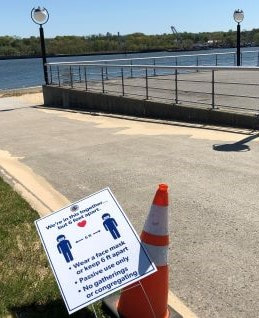|
Big-time sports returned to the tube -- and to empty stadiums -- on Saturday, with the Bundesliga returning first. Two squads -- and four socially-distanced ball persons in the four corners of the yawning stadium -- celebrated, at discreet distance. But was it worth the cost, real or potential? Many of us have been mulling this over since various major leagues have tried to figure out whether to tempt the fates, and Covid-19, by providing "bread and circuses," as one reader asked recently, citing Cicero. Just watching the normally-emotional Ruhr regional Revierderby from the safety of my living room, I could appreciate the skill of the players after a two-month layoff. But what was risked, in Germany itself or around the world? Do we need this circus when people around the world are struggling to produce....and find....the bread part? The game itself was fine. Dortmund beat FC Schalke 04, by a 4-0 score, and let us see Erling Haaland, the 19-year-old prodigy from Norway. But how many sacrifices, how many tests and masks and medical attention were spent, just to produce this spectacle? Germany may not even be the best example for the risks because, as Rory Smith pointed out in his Saturday soccer column in the NYT, Germany already has a good record in lowering the damage from the virus, plus it already has a good national health program. Germany is also blessed with Chancellor Angela Merkel, who has "the mind of a scientist and the heart of a pastor's daughter," in the words of one observer. What happens if the U.S. and Canada start playing baseball again, or hockey, or basketball or soccer? What could go wrong? I had a revelation on Friday when I joined a Zoom link of baseball/writer pals who normally have lunch once a month. A few were hopeful about a start of the baseball season, but other buffs, who can cite arcane stats from half a century ago, seemed willing to let this year slide past without baseball, so that a few more tests could be available to a giant and deprived nation. We all miss the games, but we have bigger questions. I'm not going near my barber, or doctors, or even the hardware store, until I think it won't jeopardize my wife and me. I was happy on Tuesday when some of the parks opened near me on Long Island, but only to "passive" exercise. On my way back toward my car, I spotted a miniature ball field, with artificial turf, and I stood at home plate, in the left-handed batter’s box, and pretended I was Jeff McNeil, the old-timey cult figure with the Mets. McNeil flicked his bat, smacked a single into left-center field, and I felt immense joy that this might happen sometime again soon. Then reality struck me. Should kids actually use this field this season? On Saturday, we saw German players making contact on a corner kick or running into each other "by accident.?" , Assuming labor and management can agree how to share the TV income from games in empty baseball stadiums, we might observe the players, coaches, managers and umpires all violating each other’s breathing space?  Social distancing -- until crowds arrive. Social distancing -- until crowds arrive. Given the murderous intruder, does any of this collective behavior make sense? The world is also suffering an economic crisis, cited by the disturbed man in the White House, unable to take in information from experts. Sports seem to fall into the category of "opening up" the economy. Now we have thuggish Trumpites, back up his rantings. Carry the economic "opening up" to people playing sports for our entertainment. I would hate to think the ball players are posturing about safety for a better slice of the TV pie. It's their lives at stake. The players want to play, but their concerns are obvious from the Twitter stream by Sean Doolittle, the Washington Nationals’ closer and one of the more thoughtful heads in the game. https://twitter.com/whatwouldDOOdo/status/1259920490992410626 And what about the health of clubbies who pick up damp towels the players deposit on the floor (never, ever, in the basket)? What about the physios who knead aching backs or hamstrings for hours at end? Is any of this risk worth it so players can play, and owners can take their half out of the middle? Here, I am guilty of gross hypocrisy: If they build it, I will watch -- in the safety of my den, messaging with my son in his own lair. I enjoyed watching the Bundesliga Saturday and the Fox broadcasters tried to explain the Revierderby in this vital region of Germany -- hard to tell from an empty stadium. Americans did get to see Weston McKennie start for Schalke. He's had better days, but his was better than the day of Gio Reyna of Dortmund, who hurt himself in warmups and did not play. Those were fan sub-plots. For the players and support people in empty stadiums in Germany on Saturday, these are life-gambling decisions. I hope they know what they are doing. Your thoughts? Comments welcome.
Roy Edelsack
5/14/2020 12:55:15 pm
I keep hearing how much we "need" sports during these dark times. But do we really? Or is this just a "need" by those in power to distract us from what's right in front of our eyes?
George
5/14/2020 03:27:32 pm
Wow, Roy, sensational.
Roy Edelsack
5/14/2020 04:30:27 pm
La Gazzetta dello Sport.
George
5/14/2020 05:59:35 pm
Roy: vero?
Roy Edelsack
5/14/2020 07:31:12 pm
My concerns are the risks we are expecting others to take on our behalf. Healthcare workers must accept it and we are all grateful. But do ball players have to take that risk? Meat packers? Clubhouse attendants? Waiters? To what end, my entertainment? Because I'm bored?
bruce
5/15/2020 03:59:34 pm
roy,
Bruce
5/15/2020 03:32:29 pm
george,
ANDY TANSEY
5/15/2020 09:22:14 pm
Likewise, at my age, I don't remember all I'd wish, and so I had my IQ tested. Don't worry, all's well, it came back negative. And the brain scan? 's okay too, There was nothing there. I read that Reggie was boasting in the clubhouse about his IQ and Mick the Quick said something like, "You couldn't even spell 'IQ'!"
bruce
5/15/2020 09:34:00 pm
andy,
Andy Tansey
5/16/2020 09:30:07 am
Eye blue that big thyme! Should've been, "if I am half as smart as Bruce, . . . ." :-)
bruce
5/16/2020 09:43:40 am
andy,
bruce
5/15/2020 09:43:52 pm
george,
Jim Kaplan
5/16/2020 10:53:49 pm
Thanks for sending me this, George. They should cancel the season. 5/18/2020 09:32:40 am
Great stuff about Shakespeare and Company. It covers some of what I have read about that period, Hemingway, Eugene O’Neil and his wife as well as Gertrude Stein, etc.
bruce
5/18/2020 10:22:39 am
alan, 5/18/2020 04:09:21 pm
I do not remember the dates, but here are just two examples of the effect that money has on soccer. 5/20/2020 01:07:27 pm
The NY Times obituaries always offer a wonderful world of information about people of whom I was not aware. Today’s paper highlighted the life of physicist Dr. Peter Brancazio, who had an interest in sports.
bruce
5/20/2020 01:12:49 pm
alan, Comments are closed.
|
Categories
All
|










